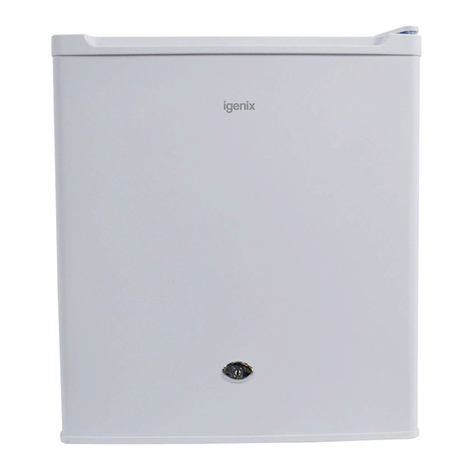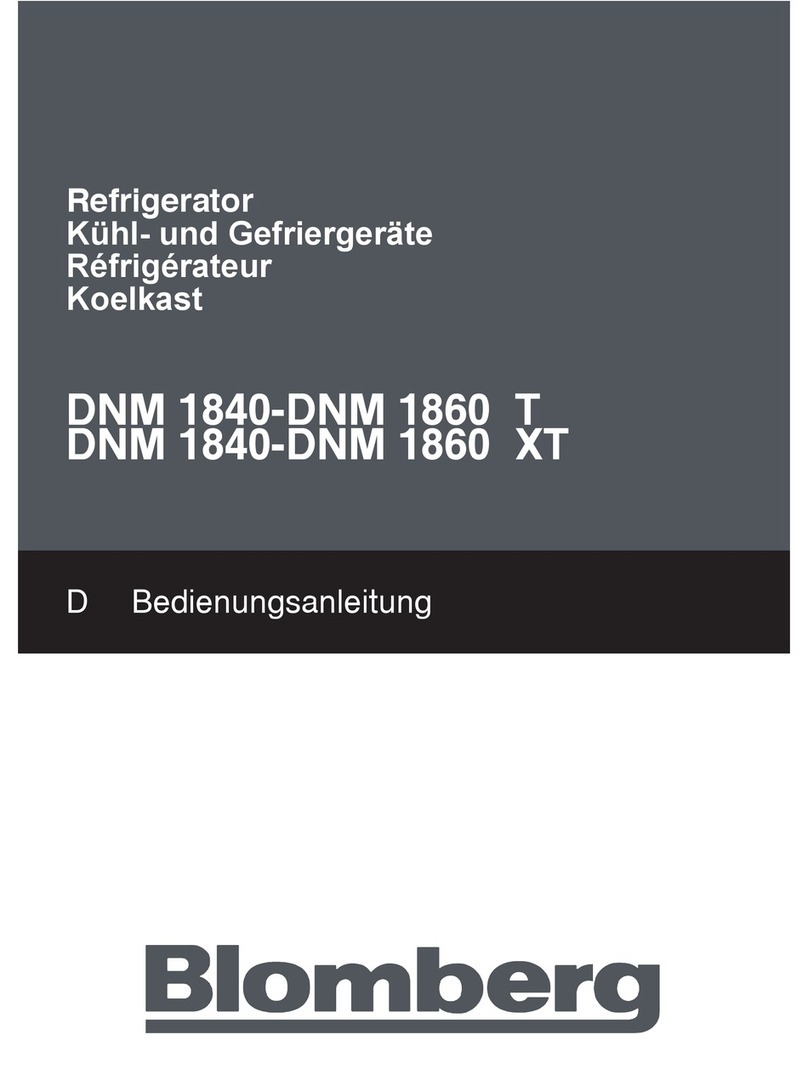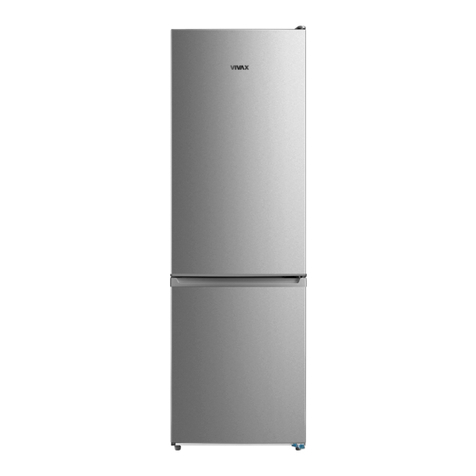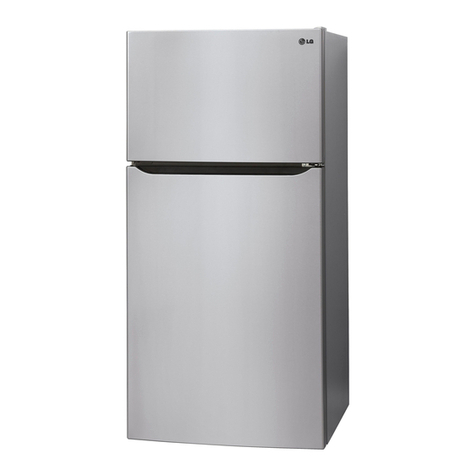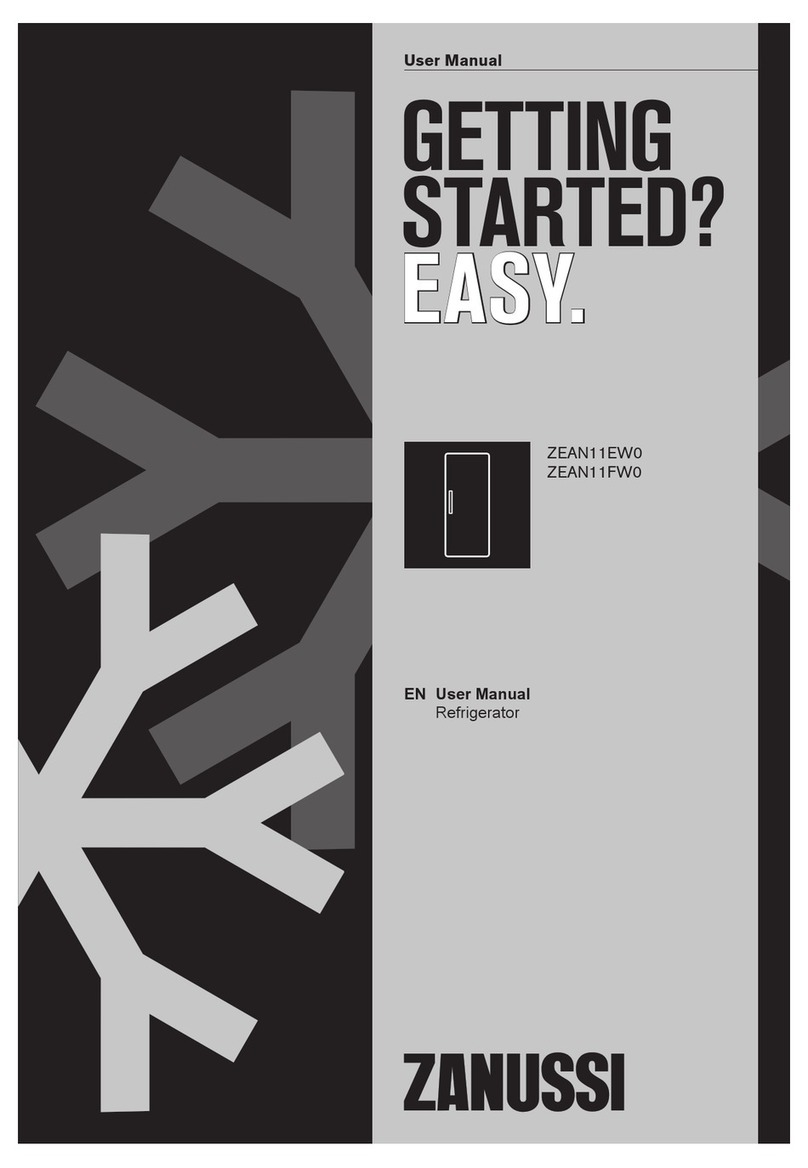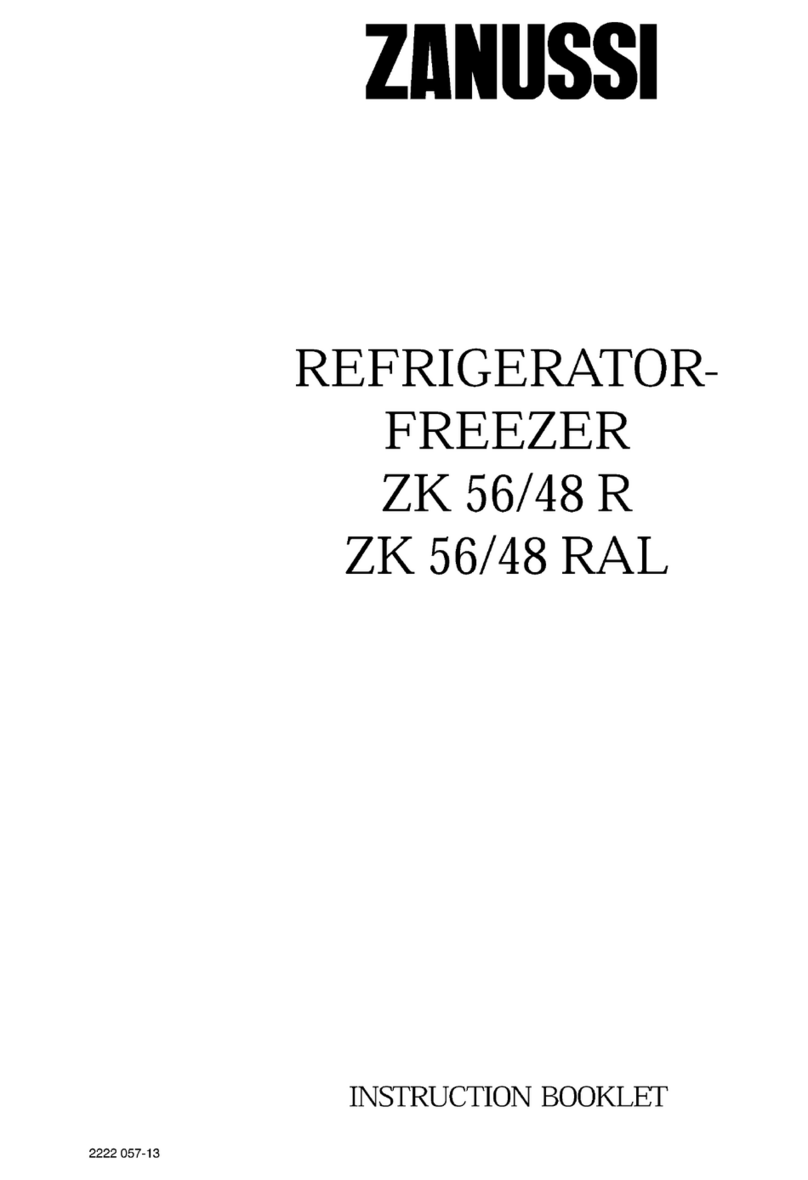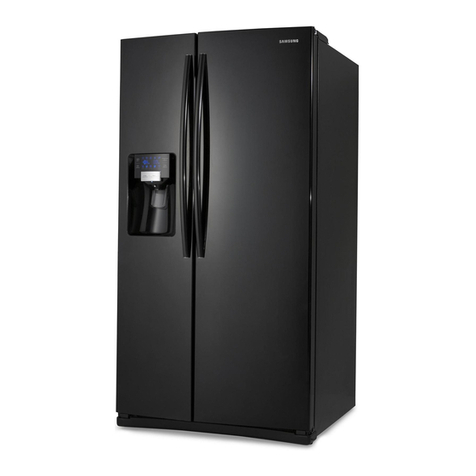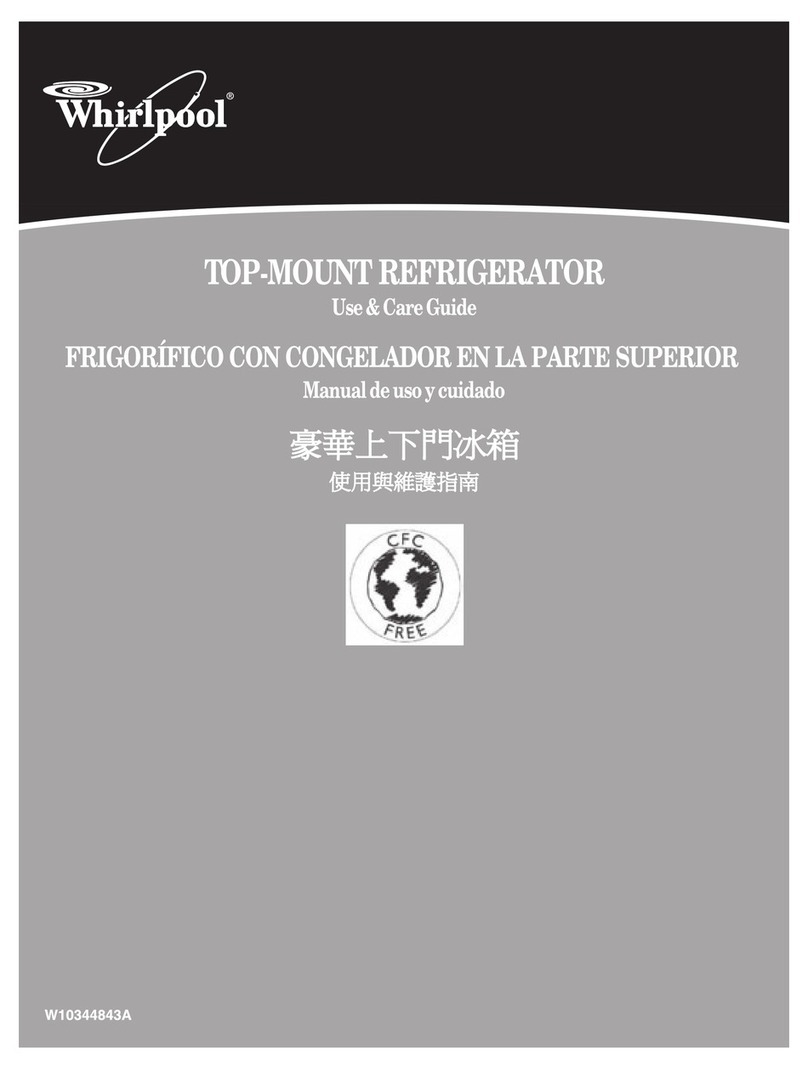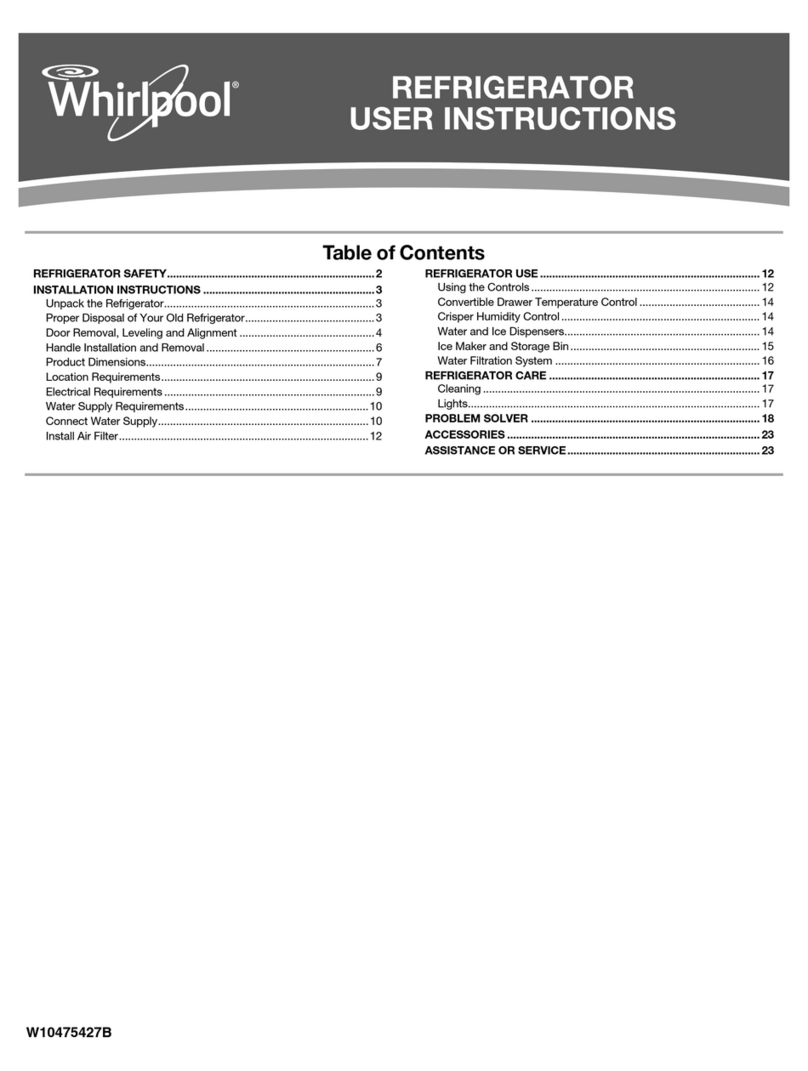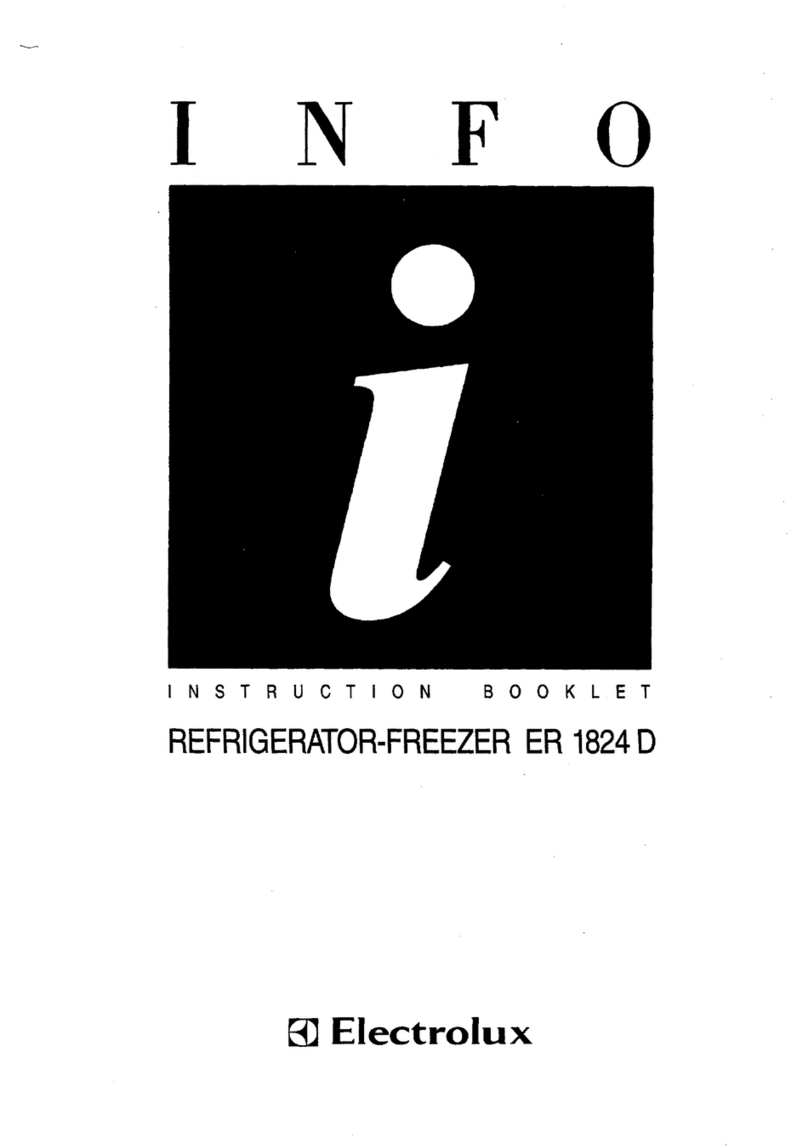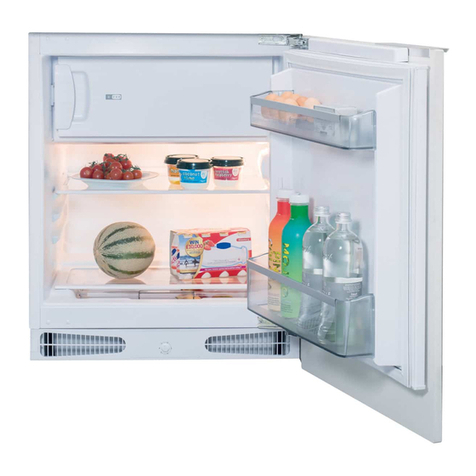iGenix IG3920 User manual

Please read these instructions carefully before use and retain for future reference
IG3920
Under Counter Fridge with Chill Box
USER MANUAL
PO Number:

2
CONTENTS
Safety Warnings........................................................................3-5
Specication .................................................................................6
Appliance Overview...................................................................6
Installation.................................................................................7-8
Operating Intructions ............................................................8-9
Cleaning & Maintenance ......................................................9-10
Troubleshooting........................................................................ 11
Fuse/Plug Replacement ........................................................... 12
Disposal Information............................................................... 12
Igenix Warranty .................................................................. 14-15

3
SAFETY INSTRUCTIONS
Read and follow all of the instructions even if you feel you are
familiar with the product, and nd a place to keep this manual handy
for future reference.
Important: This product is intended for domestic use only, for
food refrigeration and frozen food storage only.
When using electrical appliances, basic safety precautions should
always be followed:
• Do not operate the unit with a damaged cord or plug, after it
malfunctions or has been dropped or damaged in any way. All
electrical repairs must be carried out by a qualied electrician.
Inadequate repairs may result in a major source of danger for the
user and invalidate the warranty.
• Check the voltage of the appliance matches the household
voltage, which is located on the rating label.
• Use of an extension cord is not recommended with this product.
• Do not use electrical appliances inside the food storage
compartments of the appliance, unless they are recommended by
the manufacturer.
• This appliance can be used by children aged from 8 years
and above if they have been given supervision or instruction
concerning the use of the appliance in a safe way and understand
the hazards involved.
• Cleaning and user maintenance shall not be made by children
• Keep the appliance and its cord out of reach of children.
• Do not allow children to play, sit or hang onto any part of the
appliance.
• This appliance can be used by persons with reduced physical,
sensory or mental capabilities or lack of experience and
knowledge if they have been given supervision or instruction
concerning use of the appliance in a safe way and understand the
hazards involved.
• Always unplug the appliance before attempting to move it.

4
• Always unplug the appliance before cleaning. When disconnecting
from the electricity supply, pull the plug, not the cord.
• This product is for indoor use only.
• Do not store explosive substances such as aerosol cans with a
ammable propellant in this appliance.
• Do not use mechanical devices or other means to accelerate
the defrosting process, other than those recommended by the
manufacturer.
• Always keep the ventilation openings clear of obstruction. Should
they become blocked, clear them straight away.
• The refrigerant of this product is R600a which is ammable.
Ensure when moving the appliance or during installation that the
cooling system does not get damaged.
Important: Always allow 12 hours before turning on the
refrigerator to allow coolant gases time to settle after the
refrigerator is in place.
WARNING: The fridge is heavy and care is needed when unpacking
and moving it. Get extra help and only hold the fridge by the casing
– never hold by the door or the trim.
PACKAGING
The cardboard packaging is recyclable and should be disposed of
according to local regulations. Keep the packaging materials out of
the reach of children. It can become a choking or suffocation hazard.
Before installation take care to remove all cardboard or other
packaging, including material from the condenser tubes and any
material surrounding the motor / compressor unit.
DISPOSAL OF OLD APPLIANCES
Danger: Risk of child entrapment.
Before disposal of the old appliance, make sure that any locking
mechanisms have been broken off, doors have been removed but
shelves have been left in so that children cannot easily climb inside.
Also remove the plug so the appliance is unusable.

5
• Children between the ages of 3 and 8 are allowed to load and
unload refrigerators.
• When positioning the unit, make sure that the power cord is not
pinched or damaged.
• Make sure that there are no multiple sockets or power supplies
on the back of the unit.
To avoid contamination of food, please follow the instructions below:
• A prolonged opening of the door can lead to a signicant rise in
temperature in the compartments of the appliance.
• Regularly clean surfaces that may come into contact with food.
Clean the water drain regularly.
• If the appliance contains a water tank, clean it if it has not been
used for 48 hours. Rinse the tank if no water has been removed
for 5 days.
• Store raw meat and sh in suitable containers in the refrigerator
so that meat and sh do not come into contact with or drip on
other foods.
Notes on the freezer compartments:
• Two-star freezer compartments are suitable for storing pre-
frozen foods, storing or making ice cream and making ice cubes.
• One-, two- and three-star freezer compartments are not suitable
for freezing fresh food.
• If the refrigerator remains empty for an extended period, turn it
off, defrost it, clean it, dry it and leave the door open to prevent
mould from forming in the appliance.
WARNING: When using, servicing and disposing of the
unit, pay attention to the left symbol on the rear of the unit
or on the compressor. This symbol warns of possible res.
There are ammable substances in the refrigerant lines and in
the compressor. Keep the appliance away from sources of re
during use, maintenance and disposal.

6
SPECIFICATION
APPLIANCE OVERVIEW
Chill Box
Glass Shelf
Salad / Vegetable
Crisper
Bottle Shelf
Temperature Control
Egg Rack
Balcony Shelf
Contents included
Please check the following contents are included with the product and inspect the casing
for any damage. If necessary contact the retailer from where you purchased the product.
1x Full width glass shelf
1x Plastic salad crisper
1x Half width shelf over the salad crisper
Model Number IG3920
Climate Class N,ST
Refrigerator Interior Temperature (°C) 0 - 10
Chill Box Interior Temperature (°C) 0 - -6
Chill Box Star Rating 1
Total Net Capacity (Litres) 91
Voltage (V) 220 - 240
Frequency (Hz) 50
Rated Current (A) 0.7
Wattage Power 60W
Energy Rating A+/F
Noise (dB) 41
Refrigerant R600a / 21g
Blowing Gas C5H10
Net Weight (kg) 19
Gross Weight (kg) 21.5
Dimensions (mm) H 480 x W 450 x D 851

7
INSTALLATION
Location and Air Circulation
The appliance must stand vertically on a at, even surface, to level the appliance use the levelling feet by
turning them until the appliance is as level as possible.
Install the appliance in a well ventilated room with an average room temperature of between 18°C
and 38°C. The appliance should not be placed near to sources of heat e.g. cookers, radiators, direct
sunlight or in any unheated rooms e.g. garages, or outhouses, as extreme temperatures will affect the
performance of your appliance.
Do not expose the appliance to damp conditions, open air or rain.
Do not lift the appliance by the pipes or the door when moving.
Never place the appliance in a wall recess, tted cabinet or furniture as this will not allow adequate
ventilation and cause a potential re hazard. Allow 10mm of space at the sides of the refrigerator and 20
– 30mm above the refrigerator. Never push the fridge against the wall, leave at least a 10mm gap.
Providing you follow the recommended ventilation requirements you will:
• Increase the life of the fridge.
• Minimise the risk of condensation on the outside of the fridge.
• Minimise operating noises caused by vibration.
Door Fitting
The appliance door can be tted to open to either the left or the right depending on its location. The
appliance must be tilted and supported in order to carry this out. It is advisable to get some help during
this procedure. Take care when tting and tightening screws.
To change the direction of the door, please follow these instructions:
Ensure the fridge is unplugged and empty.
1. Lean the refrigerator backwards to an angle of approx. 60°
2. Remove the right adjustable foot and screw.
3. Remove the left foot, door hinge bracket and screws.
4. Slide the door down and off the hinge pin and lift away from the applance.
5. Remove the top hinge right cover carefully with a at screw driver.
6. Ret the top hinge cover on the left of the door.
7. Remove the hinge pin from the top underneath of the appliance (left side).
8. Ret the hinge pin on the top underneath of the appliance (right side).
9. Align the hinge pin to the hole in the top of the door and slide the door up.
10. Ret the foot, door hinge bracket and screws in the right side.
11. Ret the adjustable foot and screw on the left side.
12. Move the refrigerator carefully back into the upright positiion.

8
Note: Check that the door is aligned horizontially and vertically and that the seals are closed on all
sides before tightening the bottom hinge. Re-adjust the levelling feet to minimise operation noises caused
by vibration.
OPERATING INSTRUCTIONS
Before using your Refrigerator
• Allow 12 hours before turning on the refrigerator to allow coolant gases time to settle after the
refrigerator is in place. Failure to do this may result in damage to the refrigerator and such damage
is not covered by the guarantee.
• Before placing food in the refrigerator, it needs to be cleaned by wiping the interior using warm water
and a soft cloth. Wipe the refrigerator completely dry before replacing any shelves or salad drawers.
Using your Refrigerator
• Once dry plug the refrigerator into the socket.
• Adjust the temperature control which is located inside the refrigerator to between 3 and 4, this is
the correct setting to use in a room with an average ambient temperature of 20°C.
• Allow the refrigerator at least 4 hours before storing any food inside to allow for sufcient cooling
temperature to be reached.
Adjusting the Temperature
The ideal internal temperature of your refrigerator should be between 0°C to 5°C. This is regulated
by the temperature control located internally at the top of the appliance. There are 7 settings on the
temperature control, with position 7 being the coldest setting, position 1 being the warmest setting and 0
being the off position.
The temperature control should be set between 3 and 4 initially and adjusted to achieve the correct
setting for your environment. Avoid setting the thermostat too high, as this may reduce the temperature
to a point where some foods begins to freeze. If this happens turn down the thermostat slightly.
The temperature in the fridge compartment can be monitored by using a fridge Freezer Thermometer.
DO NOT USE a Mercury lled thermometer, as a breakage would cause a health hazard.
Your fridge must NOT be placed in a room where the temperature goes below 18°C or above 38°C for
prolonged periods, as the internal fridge temperature will not be maintained.

9
Using your Fridge Efciently
• Avoid opening the door for long periods or unnecessarily.
• To maintain adequate air circulation, do not over ll the refrigerator.
• Allow hot or warm foods to cool to room temperature before storing in the refrigerator.
Storing Food in your Fridge
• Pack and store cooked and fresh food separately
• Wrap raw or defrosting meats and poultry in polythene or foil and ensure they are stored below
any cooked meats to avoid contamination from any juices that may drip.
• Keep foods covered to help retain moisture and to help prevent odour. Plastic bags, aluminium foil,
plastic food wrap and containers with lids are ideal.
• Empty left over tinned food into plastic containers. Do not store foods in tins in the fridge.
• Position food in the fridge to allow cold air to circulate freely, making sure that nothing touches
the back wall of the fridge.
Defrosting the Chill Box
After a period of time frost will build up in the chill box. Regular defrosting will therefore be necessary
to maintain the efciency of the refrigerator. Defrosting should be carried out if the frost build-up begins
to interfere with the food storage. The best time to defrost your cool box is when the amount of food
stored is low. To defrost the cool box, please follow the steps below:
1. Take out the frozen food and store in either a spare freezer, refrigerator or wrap well and store in a
cool dry place. Unplug the appliance from the mains supply, making sure not to pull the cord.
Leave the door open, to speed up the defrosting process, bowls of hot water can be placed inside
the refrigerator to raise the temperature.
2. Remove the ice with an ice scrapper. DO NOT use pointed or sharp edged objects such as knives,
forks or screw drivers to remove the ice.
3. When all traces of ice have been removed and defrosting is completed, clean away any water and
wipe your refrigerator dry.
4. Clean your refrigerator as described below, plug in and switch back on, setting between 3 and 4
on your temperature control. Allow at least 4 hours for the temperature to return to the adequate
temperature before putting the food back into the refrigerator.
NOTE: Do not use any mechanical devices or other means to accelerate the defrosting process other
than those recommended by the manufacturer.
CLEANING AND MAINTENANCE
Switch off the electrical supply and remove the plug from the mains socket before cleaning.
Interior
1. Remove all food from the refrigerator and cover to help keep cool.
2. Remove all the shelves and salad crisper carefully from the fridge and wash in warm soapy water
with a soft cloth and dry thoroughly. Never replace the shelves or salad crisper into the refrigerator
if wet.
3. Wipe the interior of the refrigerator with a damp clean cloth. For extra cleaning use a solution of
one teaspoon of bicarbonate of soda to one pint of water.
4. Dry the interior thoroughly with a clean cloth and replace the shelves.
5. Plug in and switch on and allow the temperature in the refrigerator to drop back to an
adequate temperature.
6. Replace the food in the refrigerator.
NOTE: Avoid getting water into the electric components of the refrigerator i.e. the thermostat) as this
may damage your unit.

10
Exterior
Use a clean, damp soft cloth to wipe the exterior surface of the refrigerator and dry thoroughly.
WARNING: Do not use abrasive cloths, powders, household cleaners, bleach or wax polish to clean
the refrigerator as these can leave a smell in the refrigerator and can damage the exterior.
Use a vacuum cleaner to remove dust from underneath the refrigerator and from around the
compressor which is situated at the back of the refrigerator, regularly to maintain adequate ventilation.
Use caution not to damage the coolant system.
Door Seal
Use a clean, damp soft cloth to wipe the door seal and in between the creases, avoid damaging the door
seal as this will affect the performance of your refrigerator.
Drainage Channel
The drainage channel must be cleaned regularly to prevent a build-up of impurities; this can be found on
the interior back wall of your refrigerator. Use a damp clean cloth and wipe the channel clean, then use a
pipe cleaner or similar exible object to clean the drainage hole to prevent blockages
Going away
If you are going away and do not want to leave the fridge left on, switch off at the socket and remove
the plug from the mains sockets ensuring not to pull the cord. Remove any food and follow the cleaning
instructions in the “Cleaning and Maintenance” section.
Note: Leave the door ajar as this will prevent odours and mould accumulating in the refrigerator and
will allow the refrigerator to dry completely.
Power Cut
In the event of a power cut keep the refrigerator door closed to maintain the temperature inside.
Operating Sounds
You may notice some unusual noises from your refrigerator, these are perfectly normal, but you should
be aware of them.
The compressor can make a buzzing or humming sound when it is running. This can be louder when the
refrigerator is rst switched on but should become quieter in a few months.
Gases owing through the cooling systems can causer gurgling, bubbling or similar sounds. These noises
are normal and have become more pronounced since the introduction of CFC free gases.
Expansion and contraction of parts inside the refrigerator can produce a cracking noise as they rapidly
change temperature.
Changing the bulb
Disconnect the refrigerator from the mains supply. Remove the lamp cover and then unscrew the bulb,
in an anti-clockwise direction and remove bulb. Replace the bulb with a new bulb of the correct size and
type. Replace the lamp cover and then plug back into the mains supply.
Disclaimer
Updates to hardware components are made regularly. Therefore some of the instructions, specications
and pictures in this documentation may differ slightly from your particular appliance. All items described
in this guide are for illustration purposes only and may not apply to your appliance. No legal right or
entitlements may be obtained from the description made in this manual.

11
TROUBLESHOOTING
If you are having problems with your appliance, please use our troubleshooting guide below. If you are
unable to resolve the issue using this guide please ring our Customer Service Department on 01473 271
272. Please have the model code, batch number and purchase information available.
Problem Possible Cause Solution
The fridge does
not work.
1. Not properly plugged into the
mains wall socket.
2. No electricity in the mains wall
socket.
3. The door is not closed properly
1. Plug in rmly.
2. Check fuse or breaker.
3. Make sure the door is properly aligned
and creates a seal around the door.
The fridge is
making a lot of
noise.
1. The pipe work is touching the
wall or skirting board.
2. The fridge has not been levelled
properly.
1. Pull the refrigerator forward so it does
not touch the wall or skirting board.
2. Adjust the feet at the front of the fridge,
ensuring they are in rm contact with the
oor
The temperature
in the fridge is
too warm.
1. The thermostat is set too high
for your environment.
2. The fridge is too close to a heat
source.
3. There is not enough ventilation
around the fridge.
4. The door is not closed properly
1. Turn the thermostat to a higher number.
See adjusting the temperature on page 7.
2. Move the fridge away from the heat
source and out of direct sunlight.
3. Ensure there is a minimum gap of 10mm
at each side and 30mm above the fridge.
4. Ensure nothing is protruding pass the
cavity. Check that the seal is not damaged.
The temperature
in the fridge is
too cold.
1. The thermostat is set too low. 1. Turn the thermostat to a lower number.
See Adjusting the temperature on page 7.
There is water
beneath the
salad crisper and
on the oor.
1. There is something touching the
interior back wall of the fridge
1. Ensure no foods are touching the
interior back wall of the fridge.
Ice builds up
rapidly inside
the fridge.
1. Door is not closed properly.
2. Food and liquids are not
covered
1. Check to see if anything is stopping the
door from closing properly.
2. Ensure all food is covered to prevent a
build-up of moisture in the fridge.

12
Fuse Cover
Fuse Replacement (Class I)
This appliance must be eathed. Remove the fuse cover with a small
at head screw driver. Take out the fuse and replace with a new fuse
of the same Amp. Replace the fuse cover and push back into place.
MAINS PLUG FUSE REPLACEMENT
DISPOSAL INFORMATION
The European Directive 2012/19/EU on Waste Electrical and Electronic
Equipment (WEEE), requires that old household electrical appliances must not be
disposed of in normal unsorted municipal waste.
Old appliances must be collected separately in order to optimise the recovery
and recycling of the materials they contain and reduce the impact on human
health and the environment.
The crossed out “wheeled bin” symbol on the product reminds you of your
obligation, that when you dispose of the appliance it must be separately collected.
Consumers should contact their local authority or retailer for information
concerning the correct disposal of their old appliance.

13

14
lgenix Warranty Terms & Conditions
This product is guaranteed for a period of 12 months as standard from the date of purchase
against mechanical and electrical defects. You can extend your warranty for a further 12 months by
registering your product.
Upon registration we will cover your product for a period of 24 months from the original purchase
date against any mechanical or electrical defects.
To qualify for the guarantee, the product must be used for domestic household use only and in
accordance with the instructions in the user manual. Any misuse of the product will result in the
warranty being void.
The guarantee does not cover accidental damage, misuse, neglect, tampering or incorrect
adjustment or installation.
The guarantee will be rendered invalid if the product is resold, has had its serial number removed
(or has an invalid serial number), or if an unauthorised person has carried out any repairs or
alterations.
The warranty does not cover accessories or consumable parts that require replacement under
normal use. This includes shelving, dials, lters, belts and trays etc.
In the unlikely event of a breakdown please refer to the Troubleshooting guide in your user manual
and check all plugs, fuses and the electricity supply.
If you still require assistance please contact our Customer Service department on
01473 271 272 or write to us at the following address:
Customer Service Department
38 Bluestem Road, Ransomes Europark
Ipswich, IP3 9RR
Please quote the Product Code which begins ‘IG’ or ‘DF’ and the PO Number on the front of the
instruction manual and give details of the exact fault. We will then decide whether to repair or
replace the item.
Before we arrange the repair or replacement you will be required to return a copy of your proof
of purchase. Please retain your original.
If an item is replaced within the agreed guarantee period, the guarantee for the replacement item
will be calculated from the purchase date of the original.
In the event that the product is inspected and no fault is found or the product is not within the
guarantee period you will be charged for the repair and any carriage costs.

15
Thank you for choosing lgenix
As a valued customer we would like to offer you a FREE 2 year warranty to cover your product
against any electrical or mechanical defects.
This means that in the unlikely event you develop a fault or problem with your product we will
happily repair or replace the item free of charge.
To qualify for the 2 year warranty you must register your product within 30 days of purchase. The
full Terms & Conditions of our warranty policy are shown on the opposite page. They are also
available on our website. www.igenix.co.uk

38 Bluestem Road, Ransomes Europark, Ipswich, IP3 9RR
Tel. 01473 271 272
Disclaimer: Igenix operate a policy of continual improvement and development.
We therefore reserve the right to change/alter the specication and appearance of our appliances without prior notice.
All diagrams and images shown in this manual are for illustration purposes only.
Table of contents
Other iGenix Refrigerator manuals
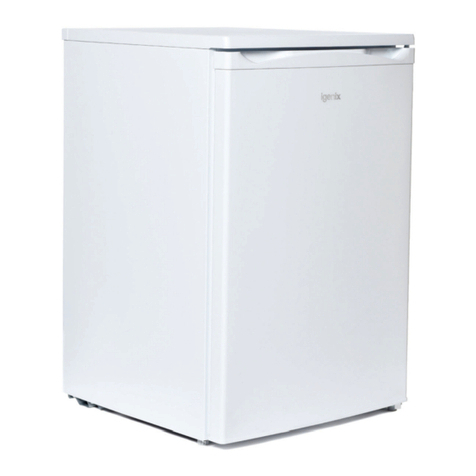
iGenix
iGenix IG255W User manual

iGenix
iGenix IG3711BL User manual
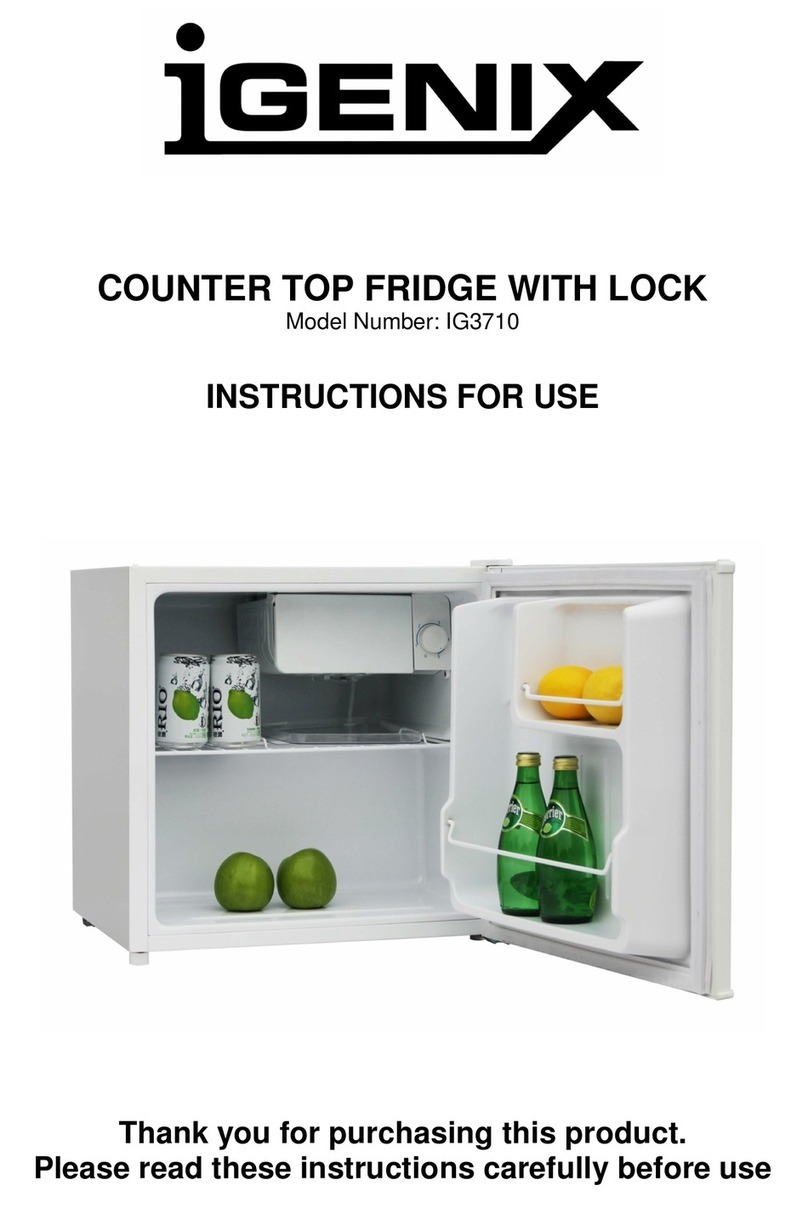
iGenix
iGenix IG3710 User manual
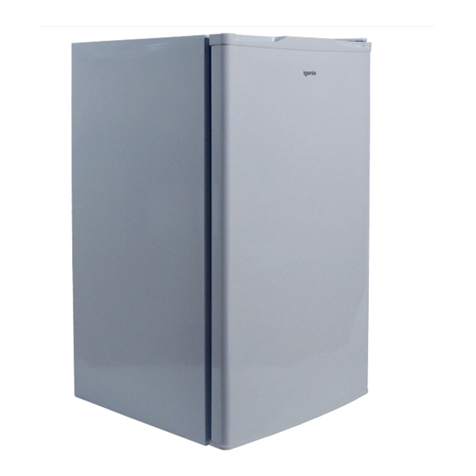
iGenix
iGenix IG348R User manual
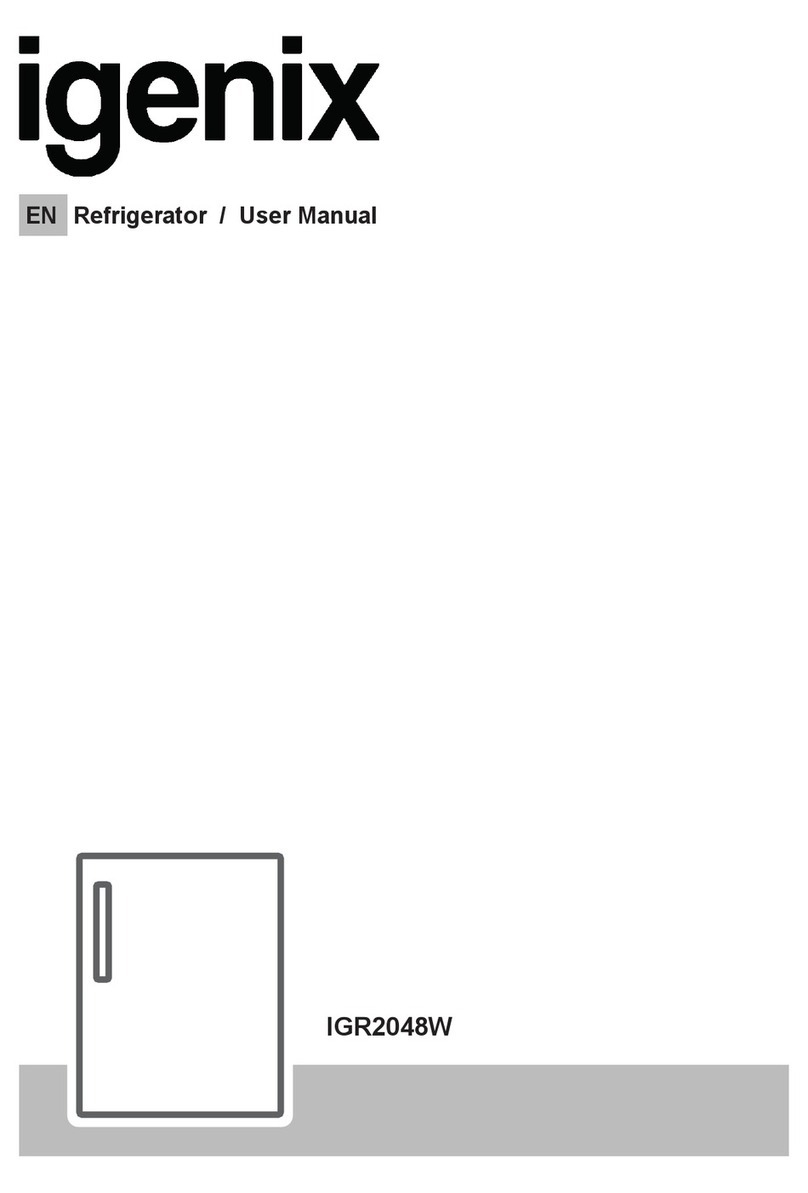
iGenix
iGenix IGR2048W User manual
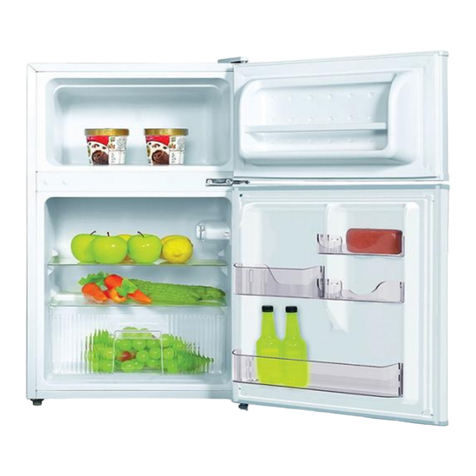
iGenix
iGenix IG347FF User manual
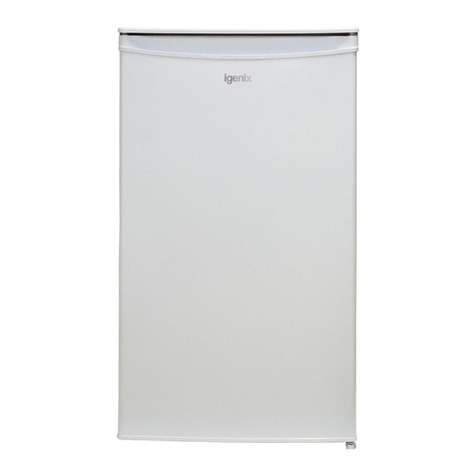
iGenix
iGenix IG3960 User manual
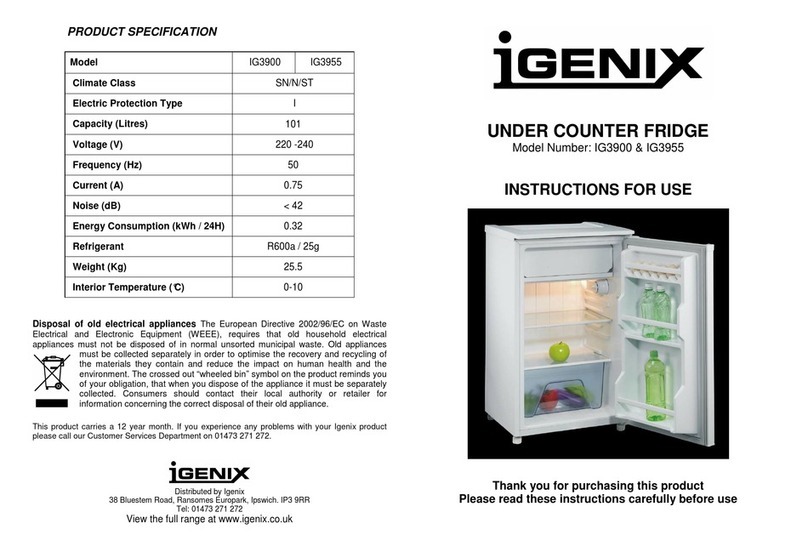
iGenix
iGenix IG3900 User manual
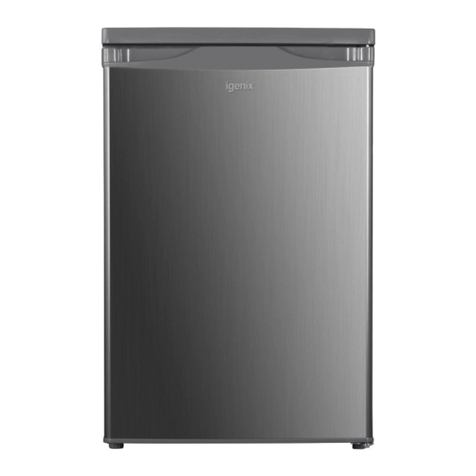
iGenix
iGenix IG255X User manual
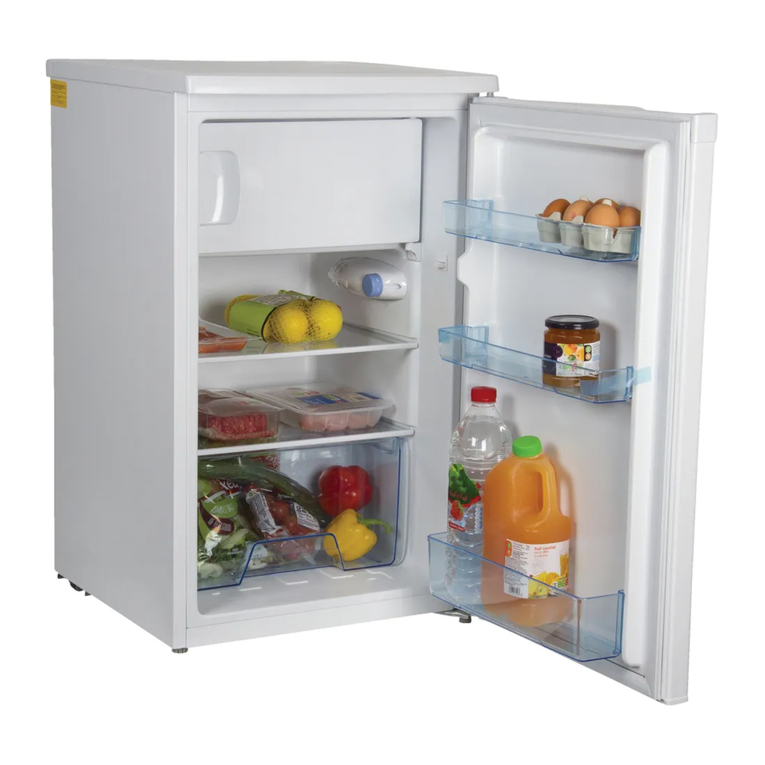
iGenix
iGenix IG350R User manual
